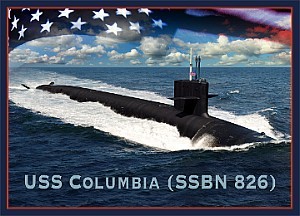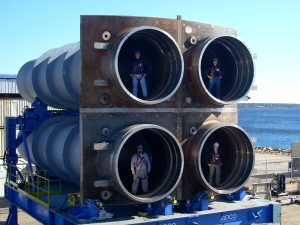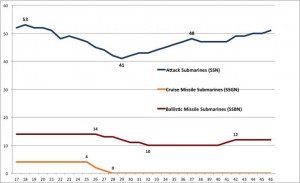Peter Lobner
On 14 December, 2016, the Secretary of the Navy, Ray Mabus, announced that the new class of U.S. fleet ballistic missile (FBM) submarines will be known as the Columbia-class, named after the lead ship, USS Columbia, SSBN-826 and the District of Columbia. Formerly, this submarine class was known simply as the “Ohio Replacement Program”.
 Columbia-class SSBN. Source: U.S. Navy
Columbia-class SSBN. Source: U.S. Navy
There will be 12 Columbia-class SSBNs replacing 14 Ohio-class SSBNs. The Navy has designated this as its top priority program. All of the Columbia-class SSBNs will be built at the General Dynamics Electric Boat shipyard in Groton, CT.
Background – Ohio-class SSBNs
Ohio-class SSBNs make up the current fleet of U.S. FBM submarines, all of which were delivered to the Navy between 1981 and 1997. Here are some key points on the Ohio-class SSBNs:
- Electric Boat’s FY89 original contract for construction of the lead ship, USS Ohio, was for about $1.1 billion. In 1996, the Navy estimated that constructing the original fleet of 18 Ohio-class SSBNs and outfitting them with the Trident weapons system cost $34.8 billion. That’s an average cost of about $1.9 billion per sub.
- On average, each SSBN spend 77 days at sea, followed by 35 days in-port for maintenance.
- Each crew consists of about 155 sailors.
- The Ohio-class SSBNs will reach the ends of their service lives at a rate of about one per year between 2029 and 2040.
The Ohio SSBN fleet currently is carrying about 50% of the total U.S. active inventory of strategic nuclear warheads on Trident II submarine launched ballistic missiles (SLBMs). In 2018, when the New START nuclear force reduction treaty is fully implemented, the Ohio SSBN fleet will be carrying approximately 70% of that active inventory, increasing the strategic importance of the U.S. SSBN fleet.
It is notable that the Trident II missile initial operating capability (IOC) occurred in March 1990. The Trident D5LE (life-extension) version is expected to remain in service until 2042.
Columbia basic design features
Features of the new Columbia-class SSBN include:
- 42 year ship operational life
- Life-of-the-ship reactor core (no refueling)
- 16 missile tubes vs. 24 on the Ohio-class
- 43’ (13.1 m) beam vs. 42’ (13 m) on the Ohio-class
- 560’ (170.7 m) long, same as Ohio-class
- Slightly higher displacement (likely > 20,000 tons) than the Ohio class
- Electric drive vs. mechanical drive on the Ohio-class
- X-stern planes vs. cruciform stern planes on the Ohio-class
- Accommodations for 155 sailors, same as Ohio
Design collaboration with the UK
The U.S. Navy and the UK’s Royal Navy are collaborating on design features that will be common between the Columbia-class and the UK’s Dreadnought-class SSBNs (formerly named “Successor” class). These features include:
- Common Missile Compartment (CMC)
- Common SLBM fire control system
The CMC is being designed as a structural “quad-pack”, with integrated missile tubes and submarine hull section. Each tube measures 86” (2.18 m) in diameter and 36’ (10.97 m) in length and can accommodate a Trident II SLBM, which is the type currently deployed on both the U.S. and UK FBM submarine fleets. In October 2016, General Dynamics received a $101.3 million contract to build the first set of CMCs.
 CMC “quad-pack.” Source: General Dynamics via U.S. Navy
CMC “quad-pack.” Source: General Dynamics via U.S. Navy
The “Submarine Shaftless Drive” (SDD) concept that the UK is believed to be planning for their Dreadnought SSBN has been examined by the U.S. Navy, but there is no information on the choice of propulsor for the Columbia-class SSBN.
Design & construction cost
In the early 2000s, the Navy kicked off their future SSBN program with a “Material Solution Analysis” phase that included defining initial capabilities and development strategies, analyzing alternatives, and preparing cost estimates. The “Milestone A” decision point reached in 2011 allowed the program to move into the “Technology Maturation & Risk Reduction” phase, which focused on refining capability definitions and developing various strategies and plans needed for later phases. Low-rate initial production and testing of certain subsystems also is permitted in this phase. Work in these two “pre-acquisition” phases is funded from the Navy’s research & development (R&D) budget.
On 4 January 2017, the Navy announced that the Columbia-class submarine program passed its “Milestone B” decision review. The Acquisition Decision Memorandum (ADM) was signed by the Navy’s acquisition chief Frank Kendall. This means that the program legally can move into the Engineering & Manufacturing Development Phase, which is the first of two systems acquisition phases funded from the Navy’s shipbuilding budget. Detailed design is performed in this phase. In parallel, certain continuing technology development / risk reduction tasks are funded from the Navy’s R&D budget.
The Navy’s proposed FY2017 budget for the Columbia SSBN program includes $773.1 million in the shipbuilding budget for the first boat in the class, and $1,091.1 million in the R&D budget.
The total budget for the Columbia SSBN program is a bit elusive. In terms of 2010 dollars, the Navy had estimated that lead ship would cost $10.4 billion ($4.2 billion for detailed design and non-recurring engineering work, plus $6.2 billion for construction) and the 11 follow-on SSBNs will cost $5.2 billion each. Based on these cost estimates, construction of the new fleet of 12 SSBNs would cost $67.6 billion in 2010 dollars. Frank Kendall’s ADM provided a cost estimate in terms of 2017 dollars in which the detailed design and non-recurring engineering work was amortized across the fleet of 12 SSBNs. In this case, the “Average Procurement Unit Cost” was $8 billion per SSBN. The total program cost is expected to be about $100 billion in 2017 dollars for a fleet of 12 SSBNs. There’s quite a bit if inflation between the 2010 estimate and new 2017 estimate, and that doesn’t account for future inflation during the planned construction program that won’t start until 2021 and is expected to continue at a rate of one SSBN authorized per year.
The UK is contributing financially to common portions of the Columbia SSBN program. I have not yet found a source for details on the UK’s contributions and how they add to the estimate for total program cost.
Operation & support (O&S) cost
The estimated average O&S cost target of each Columbia-class SSBN is $110 million per year in constant FY2010 dollars. For the fleet of 12 SSBNs, that puts the annual total O&S cost at $1.32 billion in constant FY2010 dollars.
Columbia schedule
An updated schedule for Columbia-class SSBN program was not included in the recent Navy announcements. Previously, the Navy identified the following milestones for the lead ship:
- FY2017: Start advance procurement for lead ship
- FY2021: Milestone C decision, which will enable the program to move into the Production and Deployment Phase and start construction of the lead ship
- 2027: Deliver lead ship to the Navy
- 2031: Lead ship ready to conduct 1st strategic deterrence patrol
Keeping the Columbia-class SSBN construction program on schedule is important to the nation’s, strategic deterrence capability. The first Ohio-class SSBNs are expected start retiring in 2029, two years before the first Columbia-class SSBN is delivered to the fleet. The net result of this poor timing will be a 6 – 7 year decline in the number of U.S. SSBNs from the current level of 14 SSBNs to 10 SSBNs in about 2032. The SSBN fleet will remain at this level for almost a decade while the last Ohio-class SSBNs are retiring and are being replaced one-for-one by new Columbia-class SSBNs. Finally, the U.S. SSBN fleet will reach its authorized level of 12 Columbia-class SSBNs in about 2042. This is about the same time when the Trident D5LE SLBMs arming the entire Columbia-class fleet will need to be replaced by a modern SLBM.
You can see the fleet size projections for all classes of Navy submarines in the following chart. The SSBN fleet is represented by the middle trend line.
 Source: U.S. Navy 30-year Submarine Shipbuilding Plan 2017
Source: U.S. Navy 30-year Submarine Shipbuilding Plan 2017
Based on the Navy’s recent poor performance in other major new shipbuilding programs (Ford-class aircraft carrier, Nimitz-class destroyer, Littoral Combat Ship), their ability to meet the projected delivery schedule for the Columbia-class SSBN’s must be regarded with some skepticism. However, the Navy’s Virginia-class attack submarine (SSN) construction program has been performing very well, with some new SSNs being delivered ahead of schedule and below budget. Hopefully, the submarine community can maintain the good record of the Virginia-class SSNs program and deliver a similarly successful, on-time Columbia-class SSBN program.
Additional resources:
For more information, refer to the 25 October 2016 report by the Congressional Research Service, “Navy Columbia Class (Ohio Replacement) Ballistic Missile Submarine (SSBN[X]) Program: Background and Issues for Congress,” which you can download at the following link:
https://fas.org/sgp/crs/weapons/R41129.pdf
You can read the Navy’s, “Report to Congress on the Annual Long-Range Plan for Construction of Naval Vessels for Fiscal Year 2017,” at the following link:
https://news.usni.org/2016/07/12/20627